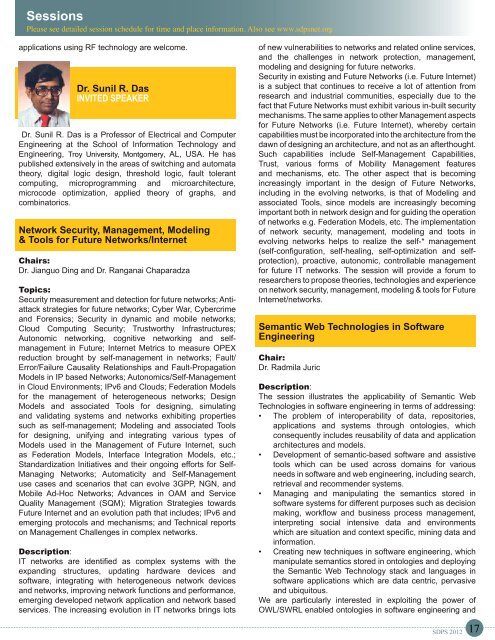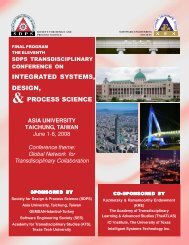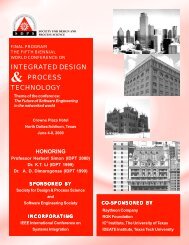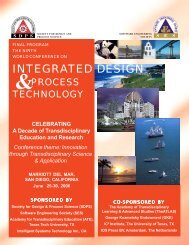Sessions - Integrated Design and Process Technology
Sessions - Integrated Design and Process Technology
Sessions - Integrated Design and Process Technology
You also want an ePaper? Increase the reach of your titles
YUMPU automatically turns print PDFs into web optimized ePapers that Google loves.
<strong>Sessions</strong><br />
Please see detailed session schedule for time <strong>and</strong> place information. Also see www.sdpsnet.org<br />
applications using RF technology are welcome.<br />
Dr. Sunil R. Das<br />
InvIted Speaker<br />
Dr. Sunil R. Das is a Professor of Electrical <strong>and</strong> Computer<br />
Engineering at the School of Information <strong>Technology</strong> <strong>and</strong><br />
Engineering, Troy University, Montgomery, AL, USA. He has<br />
published extensively in the areas of switching <strong>and</strong> automata<br />
theory, digital logic design, threshold logic, fault tolerant<br />
computing, microprogramming <strong>and</strong> microarchitecture,<br />
microcode optimization, applied theory of graphs, <strong>and</strong><br />
combinatorics.<br />
Network Security, Management, Modeling<br />
& Tools for Future Networks/Internet<br />
Chairs:<br />
Dr. Jianguo Ding <strong>and</strong> Dr. Ranganai Chaparadza<br />
Topics:<br />
Security measurement <strong>and</strong> detection for future networks; Antiattack<br />
strategies for future networks; Cyber War, Cybercrime<br />
<strong>and</strong> Forensics; Security in dynamic <strong>and</strong> mobile networks;<br />
Cloud Computing Security; Trustworthy Infrastructures;<br />
Autonomic networking, cognitive networking <strong>and</strong> selfmanagement<br />
in Future; Internet Metrics to measure OPEX<br />
reduction brought by self-management in networks; Fault/<br />
Error/Failure Causality Relationships <strong>and</strong> Fault-Propagation<br />
Models in IP based Networks; Autonomics/Self-Management<br />
in Cloud Environments; IPv6 <strong>and</strong> Clouds; Federation Models<br />
for the management of heterogeneous networks; <strong>Design</strong><br />
Models <strong>and</strong> associated Tools for designing, simulating<br />
<strong>and</strong> validating systems <strong>and</strong> networks exhibiting properties<br />
such as self-management; Modeling <strong>and</strong> associated Tools<br />
for designing, unifying <strong>and</strong> integrating various types of<br />
Models used in the Management of Future Internet, such<br />
as Federation Models, Interface Integration Models, etc.;<br />
St<strong>and</strong>ardization Initiatives <strong>and</strong> their ongoing efforts for Self-<br />
Managing Networks; Automaticity <strong>and</strong> Self-Management<br />
use cases <strong>and</strong> scenarios that can evolve 3GPP, NGN, <strong>and</strong><br />
Mobile Ad-Hoc Networks; Advances in OAM <strong>and</strong> Service<br />
Quality Management (SQM); Migration Strategies towards<br />
Future Internet <strong>and</strong> an evolution path that includes; IPv6 <strong>and</strong><br />
emerging protocols <strong>and</strong> mechanisms; <strong>and</strong> Technical reports<br />
on Management Challenges in complex networks.<br />
Description:<br />
IT networks are identified as complex systems with the<br />
exp<strong>and</strong>ing structures, updating hardware devices <strong>and</strong><br />
software, integrating with heterogeneous network devices<br />
<strong>and</strong> networks, improving network functions <strong>and</strong> performance,<br />
emerging developed network application <strong>and</strong> network based<br />
services. The increasing evolution in IT networks brings lots<br />
of new vulnerabilities to networks <strong>and</strong> related online services,<br />
<strong>and</strong> the challenges in network protection, management,<br />
modeling <strong>and</strong> designing for future networks.<br />
Security in existing <strong>and</strong> Future Networks (i.e. Future Internet)<br />
is a subject that continues to receive a lot of attention from<br />
research <strong>and</strong> industrial communities, especially due to the<br />
fact that Future Networks must exhibit various in-built security<br />
mechanisms. The same applies to other Management aspects<br />
for Future Networks (i.e. Future Internet), whereby certain<br />
capabilities must be incorporated into the architecture from the<br />
dawn of designing an architecture, <strong>and</strong> not as an afterthought.<br />
Such capabilities include Self-Management Capabilities,<br />
Trust, various forms of Mobility Management features<br />
<strong>and</strong> mechanisms, etc. The other aspect that is becoming<br />
increasingly important in the design of Future Networks,<br />
including in the evolving networks, is that of Modeling <strong>and</strong><br />
associated Tools, since models are increasingly becoming<br />
important both in network design <strong>and</strong> for guiding the operation<br />
of networks e.g. Federation Models, etc. The implementation<br />
of network security, management, modeling <strong>and</strong> toots in<br />
evolving networks helps to realize the self-* management<br />
(self-configuration, self-healing, self-optimization <strong>and</strong> selfprotection),<br />
proactive, autonomic, controllable management<br />
for future IT networks. The session will provide a forum to<br />
researchers to propose theories, technologies <strong>and</strong> experience<br />
on network security, management, modeling & tools for Future<br />
Internet/networks.<br />
Semantic Web Technologies in Software<br />
Engineering<br />
Chair:<br />
Dr. Radmila Juric<br />
Description:<br />
The session illustrates the applicability of Semantic Web<br />
Technologies in software engineering in terms of addressing:<br />
• The problem of interoperability of data, repositories,<br />
applications <strong>and</strong> systems through ontologies, which<br />
consequently includes reusability of data <strong>and</strong> application<br />
architectures <strong>and</strong> models.<br />
• Development of semantic-based software <strong>and</strong> assistive<br />
tools which can be used across domains for various<br />
needs in software <strong>and</strong> web engineering, including search,<br />
retrieval <strong>and</strong> recommender systems.<br />
• Managing <strong>and</strong> manipulating the semantics stored in<br />
software systems for different purposes such as decision<br />
making, workflow <strong>and</strong> business process management,<br />
interpreting social intensive data <strong>and</strong> environments<br />
which are situation <strong>and</strong> context specific, mining data <strong>and</strong><br />
information.<br />
• Creating new techniques in software engineering, which<br />
manipulate semantics stored in ontologies <strong>and</strong> deploying<br />
the Semantic Web <strong>Technology</strong> stack <strong>and</strong> languages in<br />
software applications which are data centric, pervasive<br />
<strong>and</strong> ubiquitous.<br />
We are particularly interested in exploiting the power of<br />
OWL/SWRL enabled ontologies in software engineering <strong>and</strong><br />
SDPS 2012<br />
17








